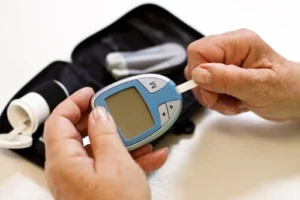Insulin therapy plays a crucial role in the management of diabetes, a condition characterized by the body’s inability to regulate blood sugar levels properly. This blog aims to shed light on the different types of insulin medication available, their uses, and tips for effective diabetes management. By understanding the nuances of each insulin type, patients can work closely with their healthcare providers to tailor a treatment plan that best suits their lifestyle and health goals.
Contents
What Is The Importance Of Insulin Medication?
 Insulin medication is fundamentally important for individuals with diabetes, particularly for those with type 1 diabetes and for many with type 2 diabetes. Its importance can be summarized through several key points:
Insulin medication is fundamentally important for individuals with diabetes, particularly for those with type 1 diabetes and for many with type 2 diabetes. Its importance can be summarized through several key points:
- Regulates Blood Sugar Levels
For people with diabetes, the body either doesn’t produce enough insulin (type 2 diabetes) or doesn’t produce any insulin at all (type 1 diabetes). Insulin medication helps to replace or supplement the body’s insufficient insulin production. It ensures that glucose can be moved from the blood into the cells for energy, thereby preventing high blood sugar levels.
- Prevents Diabetes Complications
Consistently high blood sugar levels can lead to serious health complications over time, including heart disease, kidney disease, vision loss, and neuropathy. By keeping blood sugar levels within a target range, insulin medication can help prevent or delay these diabetes-related complications.
- Improves Quality of Life
By effectively managing blood sugar levels, insulin therapy can significantly improve the quality of life for people with diabetes. It allows individuals to lead active, healthy lives without the constant worry of high blood sugar levels or the complications associated with unmanaged diabetes.
- Customizable to Individual Needs
The various types of insulin medications available today can be tailored to meet the specific needs of each individual. Factors such as lifestyle, diet, and the body’s response to insulin can influence the choice of insulin, its dosage, and the timing of injections. Hence, allows for a personalized approach to diabetes management.
Overall, insulin medication is not just a treatment; it’s a critical tool that enables individuals with diabetes to control their condition and prevent complications.
What Are The Different Types Of Insulin Medication?
 Insulin medications are categorized based on their onset (how quickly they start to work), peak time (when their effect is strongest), and duration (how long they last). Understanding these different types of insulin medication helps individuals and healthcare providers tailor diabetes treatment to fit lifestyle, meal planning, and blood sugar patterns. Here are the main types of insulin medication used in diabetes management:
Insulin medications are categorized based on their onset (how quickly they start to work), peak time (when their effect is strongest), and duration (how long they last). Understanding these different types of insulin medication helps individuals and healthcare providers tailor diabetes treatment to fit lifestyle, meal planning, and blood sugar patterns. Here are the main types of insulin medication used in diabetes management:
Rapid-Acting Insulin
- Onset: Begins to work about 15 minutes after injection.
- Peak Time: Generally peaks in 1 to 2 hours.
- Duration: Continues to work for 2 to 4 hours.
- Examples: Insulin lispro (Humalog), insulin aspart (NovoLog), insulin glulisine (Apidra).
- Usage: Often taken before meals to manage the rise in blood glucose that follows eating.
Short-acting insulin (Regular or Bolus)
- Onset: Takes effect within 30 minutes.
- Peak Time: Peaks in 2 to 3 hours.
- Duration: Works for about 3 to 6 hours.
- Examples: Regular insulin (Humulin R, Novolin R).
- Usage: Usually administered before meals and may be used in combination with longer-acting insulin.
Intermediate-Acting Insulin
- Onset: Starts working in 1 to 2 hours.
- Peak Time: Peaks in 4 to 12 hours.
- Duration: Last for 12 to 18 hours.
- Examples: NPH insulin (Humulin N, Novolin N).
- Usage: Often used twice daily to help control blood sugar levels overnight or between meals.
Long-Acting Insulin
- Onset: Begins to work several hours after injection.
- Peak Time: Has a minimal peak or no pronounced peak; it is designed to deliver insulin steadily.
- Duration: Can last for up to 24 hours or more.
- Examples: Insulin glargine (Lantus, Basaglar), insulin detemir (Levemir), insulin degludec (Tresiba).
- Usage: Provides a constant level of insulin to manage blood glucose levels between meals and overnight.
Ultra-Long-Acting Insulin
- Onset: Starts to work in 6 hours.
- Peak Time: Virtually no peak; it provides a steady effect.
- Duration: Last for more than 36 hours.
- Examples: Insulin degludec (Tresiba) falls into this category for some dosing schedules.
- Usage: Designed for once-daily dosing to provide a steady background level of insulin.
Pre-Mixed Insulin
- Composition: Combines specific proportions of intermediate-acting and short- or rapid-acting insulin in one vial or pen.
- Onset, Peak Time, and Duration: Varies, depending on the mixture.
- Examples: Various brands and mixtures are available, including NovoLog Mix 70/30 (insulin aspart protamine and insulin aspart) and Humalog Mix 75/25 (insulin lispro protamine and insulin lispro).
- Usage: Simplifies regimen for those who benefit from both types of insulin but prefer fewer injections.
The choice of insulin type depends on the individual’s blood sugar patterns, lifestyle, preferences, and how their body responds to insulin. By understanding the characteristics of each type of insulin, patients and healthcare providers can develop a more effective diabetes management plan.
What Is The Most Common Type Of Insulin Medication?
The most common type of insulin medications typically include formulations that are widely used across the spectrum of diabetes management. Specific examples include:
- Regular Human Insulin (Short-Acting): Products like Humulin R and Novolin R have been staples in diabetes care for decades. They are often used for mealtime coverage and can be adjusted based on the carbohydrate content of meals.
- NPH Insulin (Intermediate-Acting): Humulin N and Novolin N are examples of NPH insulins that have been widely used for basal coverage, providing insulin action that lasts significantly longer than regular human insulin but with a peak.
- Insulin Glargine (Long-Acting): Lantus is a very common long-acting insulin, offering a more constant insulin level for up to 24 hours, which helps manage blood glucose levels overnight and between meals. Its analogs, like Basaglar, a biosimilar, are also popular.
- Insulin Lispro (Rapid-Acting): Humalog is among the most commonly used rapid-acting insulins. And, is designed to be taken shortly before or after meals to help control blood sugar spikes.
- Insulin Aspart (Rapid-Acting): NovoLog is another widely used rapid-acting insulin. It is similar to Humalog in its timing and use for mealtime blood sugar control.
The choice of insulin is highly individualized, depending on factors such as the person’s daily routine, their body’s response to insulin, the progression of their diabetes, and their overall management goals.
What Are The Risks And Considerations With Insulin Medications?
 While insulin medications are highly effective in managing diabetes, they also come with certain risks and considerations that individuals should be aware of. Here are some important points to consider:
While insulin medications are highly effective in managing diabetes, they also come with certain risks and considerations that individuals should be aware of. Here are some important points to consider:
Hypoglycemia (Low Blood Sugar)
- Risk: Insulin therapy can sometimes lead to hypoglycemia, especially if the dose is too high, meals are skipped, or physical activity levels change unexpectedly.
- Consideration: It’s important to monitor blood sugar levels regularly and be aware of the signs and symptoms of hypoglycemia, such as shakiness, sweating, dizziness, and confusion. Prompt treatment with fast-acting carbohydrates is necessary to raise blood sugar levels back to normal.
Weight Gain
- Risk: Some individuals may experience weight gain while on insulin therapy, particularly if their blood sugar levels improve and their body begins to store excess glucose as fat.
- Consideration: Healthy eating habits and regular exercise can help mitigate weight gain. Working with a healthcare provider or dietitian to develop a balanced meal plan is essential.
Injection Site Reactions
- Risk: Insulin injections can sometimes cause redness, swelling, or itching at the injection site.
- Consideration: Rotating injection sites and using proper injection techniques can help minimize injection site reactions. If irritation persists or worsens, it’s important to consult a healthcare provider.
Allergic Reactions
- Risk: While rare, some individuals may develop allergic reactions to insulin medications, particularly those containing additives or preservatives.
- Consideration: If symptoms of an allergic reaction occur, such as rash, hives, or difficulty breathing, immediate medical attention is necessary. Alternative insulin formulations may be recommended.
Lipodystrophy
- Risk: Prolonged insulin injection at the same site can lead to the development of fatty lumps or indentations under the skin, known as lipodystrophy.
- Consideration: Rotating injection sites and avoiding repeated injections in the same area can help prevent lipodystrophy. Consulting with a healthcare provider for guidance on proper injection technique is advisable.
Hypokalemia (Low Potassium)
- Risk: Insulin therapy can sometimes lead to a decrease in potassium levels in the blood, known as hypokalemia.
- Consideration: Monitoring potassium levels periodically and consuming potassium-rich foods, such as bananas, potatoes, and spinach, can help maintain a healthy balance. Supplemental potassium may be prescribed if levels are low.
Pregnancy and Breastfeeding
- Risk: Pregnant or breastfeeding individuals with diabetes may require adjustments to their insulin regimen to maintain optimal blood sugar control.
- Consideration: Close monitoring by a healthcare provider experienced in managing diabetes during pregnancy and breastfeeding is essential to ensure the health of both the mother and the baby.
Overall, insulin therapy is essential for many individuals with diabetes. Thus, it’s important to be aware of the potential risks and considerations associated with its use.
Conclusion
In conclusion, types of insulin medication is a crucial tool for managing diabetes effectively, helping individuals regulate their blood sugar levels and prevent complications. While insulin therapy offers many benefits, it’s essential to be aware of potential risks and considerations, such as hypoglycemia, weight gain, and injection site reactions.
With proper education, support, and access to affordable treatment options, people with diabetes can lead fulfilling lives. Also, effectively managing their condition with insulin medication. Do you want to get rid of diabetes? Join our online diabetes treatment program and reverse Diabetes naturally through lifestyle changes such as a Personalized Diet plan, Exercise, Yoga, dieticians, and health coaches.

